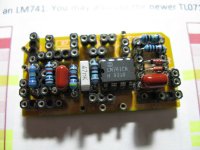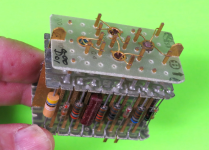Feral Feline
Well-known member
Yes, once breadboarded, you can do whatever you want — in fact, you can do MORE because you're not constrained — for instance you can tinker with a Muff and swap out the tone-stack for a Fender BASS MIDS TREBLE tone-stack far more easily on a breadboard than trying to mock-up the Fender tone-stack on a socketed PCB, which would be a nightmare.
Nonetheless, for me it's easier to swap out component-values on a socketed Muff PCB if that's the only thing I'm messing with — component values — since I'm trying dozens upon dozens of variations from Kit Rae's Web-site.
A Rat PCB, on the other hand — there just aren't as many variations that I'm interested in on a Rat. So it makes no sense to me to socket a Rat PCB, I'd rather just breadboard the Rat variant.
With the socketed EMEXAR, it was worth it to me to devote a PCB to sockets. Variants of several circuits have been explored on it, in addition to the ones mentioned in my previous post, there are multiple ways of tweaking EACH of the following as well:
Ross
Blue Clipper
Boosta Grande
Beta
Red Lights
Adamu
Wampler mods
White Light
Zoom
Janus
Drivestortion
Liquid Drive
Sole Pressure
Quantum Mystic
... several more I'm forgetting.
Before I even had a breadboard, I socketed an entire GPCB EMEXAR PCB.
It still gets used as I'd rather grab it than lay out a breadboard for a variant of that circuit — the layout of the socketed PCB is already done for you. There you go, that's the advantage over breadboarding a circuit, the layout is already done for you.
Remember this thread?
cannot be overstated how valuable and worthwhile breadboarding is.
and not only does it help you learn and explore circuits/mods a lot quicker, it gives you the option to try out and play a circuit that you might not normally care for or commit to building. really opens things up.
If I'm only going to be experimenting with clipping-diodes on a circuit, why breadboard it? Just build the PCB and socket the clipping diodes and IF, and only if I manage to settle on one set of diodes over all the optionitis that exists, I can still solder the Chosen Ones in place.
At least for me, I can SEE what's going on with a socketed PCB better than I can see what's going on with a breadboarded layout;
maybe that's because of a reduction of visual information, labelling on the PCB... whatever.


 Nice and neat, organised, can easily follow the signal flow...
Nice and neat, organised, can easily follow the signal flow...
versus...
Chaos:



Shoulda "breadboarded the one above on my fully socketed MUFF PCB...

A fully socketed PCB IS a breadboard, of sorts.
With it, I stick the populated-socketed-PCB in an enclosure and take it over to my friend-with-the-golden-ears for further circuit tweaking, and if he still gigged, he could take it to the gig and try it in the heat of Sonic-Battle...
Now...
...Back to perf layouts.
Nonetheless, for me it's easier to swap out component-values on a socketed Muff PCB if that's the only thing I'm messing with — component values — since I'm trying dozens upon dozens of variations from Kit Rae's Web-site.
A Rat PCB, on the other hand — there just aren't as many variations that I'm interested in on a Rat. So it makes no sense to me to socket a Rat PCB, I'd rather just breadboard the Rat variant.
With the socketed EMEXAR, it was worth it to me to devote a PCB to sockets. Variants of several circuits have been explored on it, in addition to the ones mentioned in my previous post, there are multiple ways of tweaking EACH of the following as well:
Ross
Blue Clipper
Boosta Grande
Beta
Red Lights
Adamu
Wampler mods
White Light
Zoom
Janus
Drivestortion
Liquid Drive
Sole Pressure
Quantum Mystic
... several more I'm forgetting.
Before I even had a breadboard, I socketed an entire GPCB EMEXAR PCB.
It still gets used as I'd rather grab it than lay out a breadboard for a variant of that circuit — the layout of the socketed PCB is already done for you. There you go, that's the advantage over breadboarding a circuit, the layout is already done for you.
Remember this thread?
same.Well I kicked myself harder for not breadboarding sooner — it was easy-peasy, once past the initial mental hurdle, the learning curve is super-swift.
cannot be overstated how valuable and worthwhile breadboarding is.
and not only does it help you learn and explore circuits/mods a lot quicker, it gives you the option to try out and play a circuit that you might not normally care for or commit to building. really opens things up.
If I'm only going to be experimenting with clipping-diodes on a circuit, why breadboard it? Just build the PCB and socket the clipping diodes and IF, and only if I manage to settle on one set of diodes over all the optionitis that exists, I can still solder the Chosen Ones in place.
At least for me, I can SEE what's going on with a socketed PCB better than I can see what's going on with a breadboarded layout;
maybe that's because of a reduction of visual information, labelling on the PCB... whatever.

versus...
Chaos:
Shoulda "breadboarded the one above on my fully socketed MUFF PCB...
A fully socketed PCB IS a breadboard, of sorts.
With it, I stick the populated-socketed-PCB in an enclosure and take it over to my friend-with-the-golden-ears for further circuit tweaking, and if he still gigged, he could take it to the gig and try it in the heat of Sonic-Battle...
Now...
...Back to perf layouts.





